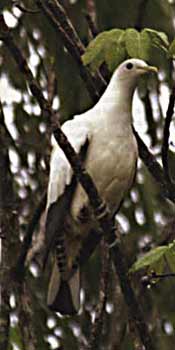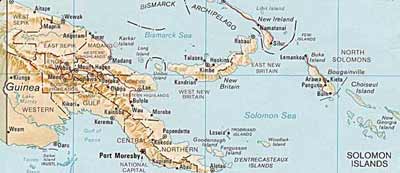Pigeons in Papua
by Robert Piper
Hunter 10
 "How many pigeons did you get?" the old Papuan lady, Mokuku, asked me in
her own language as the canoe slid up the black sandy beach. "Sau doi
doi labui," (12) I replied. She burst out laughing and beamed in
delight at the feast she and her small village would have that night.
My fellow Papuan hunters had already briefed me and I knew the question
she would ask when we returned. The canoe ride back to the village had been a quick language course on how I would reply.
"How many pigeons did you get?" the old Papuan lady, Mokuku, asked me in
her own language as the canoe slid up the black sandy beach. "Sau doi
doi labui," (12) I replied. She burst out laughing and beamed in
delight at the feast she and her small village would have that night.
My fellow Papuan hunters had already briefed me and I knew the question
she would ask when we returned. The canoe ride back to the village had been a quick language course on how I would reply.
The Torres Strait pigeon, also known as the nutmeg pigeon, derives its former and most popular name from the area it mostly frequents.
It is a white bird with black on the tips of its wings and some yellow flecking around the neck. It can be found across most of northern Australia, from the Kimberley in Western Australia to northern Queensland.
However, its most popular habitat is the Torres Strait, between the tip of Cape York Peninsula and Papua New Guinea. We now know that it also flies as far as the eastern tip of Papua.
Breeding mostly off the coast it feeds on the mainland each day, returning to an island refuge at night. The bird's main diet is an abundance of fruits and berries and as a result, they are quite a solid pigeon and much sought after by island people.
The Torres Strait pigeon was always an elusive bird for the Suau people of eastern Papua. It was only in recent years that opportunities to hunt them improved, with the advent of affordable, single-shot, 12-gauge shotguns.
Before the introduction of firearms, a lucky arrow brought home the evening meal. The bow did have one advantage over the shotgun - it was silent and didn't put the other birds to flight. Finding missing arrows was another story though.
Suau people live along the coastal fringe and islands of south-east Papua not far from the more famous Milne Bay and its battles of World War II.
With a low population density, the quiet and gentle people are scattered in small family communities over a stretch of about 80 kilometres. Superb seaman from the time they can walk, they don't often venture too far inland on the steep islands, but still managed to occasionally score a wandering pig with their ancient single shotguns.
While only 53 people populated the village when I was there, it took a full 12 hours to walk around the perimeter of the island of Bona Bona, where I was staying. Its remoteness meant that only a few families, mostly related, lived in small villages around the scattered beaches.
While fish, vegetables and fruit were plentiful in the area, fresh meat was a rarity among the coastal people. The occasional wild pig or flying fox sometimes supplemented their diet but it was the plump and elusive Torres Strait pigeon they dearly sought.
For myself, down from Moresby in the early 1970s, it was a young man's dream and a true tropical paradise. At the time I had an unusual .22 Colteer rifle (made by Colt), fitted with a low- power but quality Bushnell telescopic sight. It was the ideal choice for the Torres Strait pigeons, which hid among the treetops in the small islands off- shore. The scope allowed me to search the foliage in the low light and the report of a .22 did not disturb the other birds. In most cases the thick jungle also muffled the sound.
The islands were only a few acres in side, with steep sides that make for a dark interior when down among the base of the trees. In fact, these islands were probably the tips of ancient mountains protruding up out of the sea in the area. For the pigeons, they had been an ideal source of refuge from local hunters and sea eagles. The loud blast from the Papua hunter's single-shot guns made hunting difficult when searching for the pigeons. It usually set the pigeons to flight. If hit, the birds often spiralled down from the overhanging trees and into the water below, to sink immediately. The islanders created a system to counteract this. The majority of the hunting party would stay on the island to shoot the birds and one or two hunters, in canoes, would circle below to snatch the birds if they headed for the sea.
 This particular late afternoon was probably the most successful pigeon
hunt the locals had ever had. Working as a team and with the sham-eyed
Papuan boys pointing out the bird silhouettes, we slowly worked our way
across and around the edge of the island. The score was a magnificent
12.
This particular late afternoon was probably the most successful pigeon
hunt the locals had ever had. Working as a team and with the sham-eyed
Papuan boys pointing out the bird silhouettes, we slowly worked our way
across and around the edge of the island. The score was a magnificent
12.
Resting as the sun set and darkness began to overtake us, we sat down on the edge of a cliff looking south and gathered a little of the cool sea breeze.
It dawned on me suddenly that there was nothing but 700 kilometres of ocean between where I was sitting and Australia. It was a long way from home for a former Sydney suburbs boy. I felt like Robinson Crusoe - isolated.
The trip back to the village was in the usual precarious canoe - I hated the thing. Unsteady, low freeboard and the risk of going overboard. Always being conscious that my rifle could be committed to a watery grave in the event of an upset- As we paddled back, somewhere in the depths below us lay the broken remains of an American B-52 Mitchell bomber, one of three lost on a flight from Australia to New Guinea in 1942.
The captain had attempted a water-landing, misjudged and crashed. A nose wheel, which had later floated ashore, was kept in the local village as proof of the tragedy.
Only a week earlier I had stepped on a sea urchin and my heel was painfully pierced and full of spikes. It was a serious situation. I was a long way from civilization and infection would set in very quickly in the moist and wet climate. When the local people approached me with a flat-topped stone and claimed they could fix my heel, I thought I was becoming delusional. But fix it they did. The spikes were, in fact, of a shell-like quality and pounding my heel with the stone didn't actually drive them deeper.
It shattered them into thousands of tiny pieces, which dissipated into the skin and dissolved, causing no further problems.
I was a babe in the woods and jungle in Papua and still on a steep learning curve, despite many earlier years bush walking and hunting in Australia.
My heart has never left the Suau people and the fishing and hunting experiences we shared together. They are a courteous people who taught me so much, when I knew so little about their environment.
Readers will be pleased to know that the author maintains contact with the Suau people by letter. Mokuku's granddaughter, aged eight at the time I met her, still corresponds after 30 years and keeps me up-to-date with life on the island - via photos from disposable cameras.
